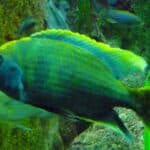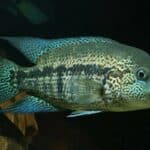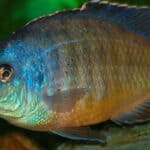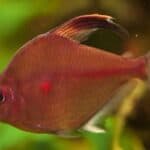Most people who start keeping fish do so with the intention of keeping just a small fish. They may not have the time, space, or budget to keep a large one, so they stick to a manageable size.
However, some people take on the challenge of keeping a large fish, and they often find that they enjoy the generous size and additional work that comes with it. The Tinfoil Barb is a good option if you are one of them.
Species Summary

Tinfoil Barbs (Barbus schwanenfeldii) are found in Asia, the Mekong Basin and Chao Phraya Peninsula, Malaya, Sumatra, and Borneo. They thrive in medium-sized river channels and tributaries but are increasingly being found in artificial canals and lakes.
During the wetter months, they will move to flooded riparian areas and forests to feed and spawn. However, they will return to rivers as the water begins to recede.
These fish are Barbs, which belong to the Cyprinidae family, like the carp and goldfishes. As well as being very peaceful fishes, they also form large schools.
Tinfoil Barb Care Guide
This hardy and easy-to-care fish is a great addition to any aquarium, but as with any other species, there are some peculiarities to be aware of.
Tank Size
Barbs are large fish and need to be kept in a school of at least six individuals. Therefore, you’ll need an aquarium that is at least 70″ x 20″. This size can accommodate a small group of barbs, but always remember that the more space available, the better the welfare of the fish.
In addition to tank size, another important factor to consider is tank length. Barbs need a lot of swimming space, so a long tank is ideal. A tank that is at least 48″ long will give them plenty of room to swim and explore.
If you can provide a large, long tank for your barbs, they will thrive in your freshwater aquarium.
Tank Mates
These fish get along well with other animals and can coexist peacefully with other fish species. However, there are a few things to remember when choosing tank mates for your Tinfoil Barb.
Avoid aggressive and larger species that could injure the Tinfoil Barb, or that will compete directly for food. Suitable tank mates for the Tinfoil Barb include robust fish of similar or larger size, such as Oscar Fish, Bala Shark, Red-tailed Black Shark, Angelfish, Silver Dollar, Arowana, Large Plecos, Fire Eel, Clown Loach, and Central American Cichlids.
Likewise, smaller fish and anything that fits in their mouths can become food for the Tinfoil Barb, so avoid using fish with these characteristics.
Same Species Tanks
Often kept as a single species, these fish are native to South Asia and are known for their stunning black and gold coloration. They’re a great addition to any aquarium, and their peaceful nature makes them a perfect choice for beginners and experienced fishkeepers alike.
Water Parameters
These fish will do well in any tank, but it’s always important to monitor water parameters and ensure your fish are healthy and happy.
The ideal temperature for keeping Tinfoil Barbs is 71 to 82 degrees Fahrenheit, and the ideal pH range is between 6.0 and 8.0. Hardness should be kept below 10 degrees.
What to Put in Their Tank
You’ll need a spacious aquarium – these fish can grow up to 14 inches in length, so they need room to move around. You’ll also need to invest in a good quality heater, filtration system, and a sturdy lid to prevent your fish from escaping.
In terms of decor, it’s best to keep things relatively simple. Tinfoil Barbs are not particularly fussy fish and don’t need many hiding places or elaborate decorations. A few plants and some rocks or driftwood will suffice.
Common Diseases
They’re remarkably disease-resistant fish. Of course, that doesn’t mean you can neglect your fish or the water quality in their tank. Like all fish, they still need clean water and good quality food to stay healthy.
But, overall, the Tinfoil Barb is a hardy fish that is a great option for beginning fishkeepers or those who don’t want to worry about their fish getting sick.
Food and Diet
This species is an opportunistic omnivore, which means it will pretty much eat anything it can fit in its mouth. Studies have shown that the Tinfoil Barb is primarily a herbivore in the wild, feeding on aquatic macrophytes, land plants, and filamentous algae.
But don’t worry if there’s not much plant life available; the Tinfoil Barb is more than happy to switch things up and munch on smaller fish or invertebrates. And if there’s really nothing else around, it has even been known to eat carcasses of other animals.
However, it can be tough to keep up with their constant demand for food, but it’s important to do your best to provide them with a balanced and nutritious diet.
One way to make sure your Tinfoil Barb is getting everything it needs is to set a regular feeding schedule. This will help you to avoid overfeeding, which can be dangerous to the fish.
It’s also vital to offer a variety of different types of food. While they love to eat just about anything, giving them a mix of proteins, vegetables, and other healthy ingredients is important.
Lifespan
The lifespan of a Tinfoil Barb largely depends on the conditions in which it lives. In captivity, they can live up to 10 years with proper care. The average lifespan in the wild is much shorter, as they are susceptible to diseases and predators.
Appearance
This fish has the traditional hexagonal shape of barbs, with large silvery scales and a metallic shine resembling aluminium foil, which is why the species has earned its popular name.
Adult individuals at their most full size is typically a silvery or golden yellow color, with a red dorsal fin and an orange or blood-red caudal fin.
Size
While they can grow to be quite large (up to 14 inches), the average size you’ll see in pet stores is around 8 inches.
Behavior and Temperament
The Tinfoil Barb is a tropical fish that’s known for its active and vigorous feeding behavior. While they’re not usually aggressive, they can disturb other, more timid fish with their constant activity.
Tinfoil barbs are found in large schools in their natural environment, so it’s best to keep at least six specimens together to avoid fights. If you keep them in pairs or trios, there may be severe persecution of the weakest of the group.
These fish are very active, occupying practically all strata of the tank. However, they prefer to feed on the surface. So, if you have other fish that compete for surface space, you may need to provide more than one feeding station.
Breeding
It is an oviparous species, where the female freely dumps the eggs in the middle (egg-scattering species). In nature, its reproductive period follows the rhythm of floods, with the change in water chemistry being one of the main factors triggering the reproductive process.
The mating ritual begins with the male showing himself to the female, who will disperse the eggs freely along the substrate. These eggs will be fertilized promptly by the male. It produces a large litter, a single female able to release thousands of eggs.
If given a chance, the parents do not exhibit parental care and will eat all eggs and fry.
Gender Differences: Male vs Female
There are some pretty clear gender differences. Mature females are generally much more stocky than males, especially during the breeding season. This is likely due to the fact that they need to carry around a lot more eggs than their male counterparts.
Tinfoil Barb Fun facts
● Its distribution is quite comprehensive, covering practically all of Southeast Asia. It is present in several critical river systems, including the Mekong and Chao Phraya basins. Very popular locally for consumption.
● This Barb is one of two species traded under the common name of ‘tinfoil,’ the other being its lesser-known congener B. altus. There are varieties developed for the ornamental fish trade, including the “golden” and “blushing” varieties. These were selectively bred for the trade and are slightly brighter in color than wild fish.
● B. schwanefeldii can also be seen with variations in the spelling of the specific epithet, such as schwanefeldi or schwanenfeldii. Bleeker made a misspelling in naming the species that he later tried to change. The name B. schwanenfeldii was commonly used until Kottelat (2013) corrected it because Bleeker’s error was unintentional and, therefore, should be corrected.
References
Baird, I.G., V. Inthaphaisy, P. Kisouvannalath, B. Phylavanh and B. Mounsouphom, 1999. The fishes of southern Lao. Lao Community Fisheries and Dolphin Protection Project. Ministry of Agriculture and Forestry, Lao.
Christensen, M.S., 1992. Investigations on the ecology and fish fauna of the Mahakam River in East Kalimantan (Borneo), Indonesia. Int. Rev. Gesamt. Hydrobiol.
Kottelat, M., 1998. Fishes of the Nam Theun and Xe Bangfai basins, Laos, with diagnoses of twenty-two new species (Teleostei: Cyprinidae, Balitoridae, Cobitidae, Coiidae and Odontobutidae). Ichthyol. Explor. Freshwat.
Kottelat, M., A.J. Whitten, S.N. Kartikasari and S. Wirjoatmodjo, 1993. Freshwater fishes of Western Indonesia and Sulawesi. Periplus Editions, Hong Kong.
Mills, D. and G. Vevers, 1989. The Tetra encyclopedia of freshwater tropical aquarium fishes. Tetra Press, New Jersey.
Mohsin, A.K.M. and M.A. Ambak, 1983. Freshwater fishes of Peninsular Malaysia. Penerbit Universiti Pertanian Malaysia.
Rainboth, W.J., 1996. Fishes of the Cambodian Mekong. FAO species identification field guide for fishery purposes. FAO, Rome
Roberts, T.R., 1989. The freshwater fishes of Western Borneo (Kalimantan Barat, Indonesia). Mem. Calif. Acad. Sci.








